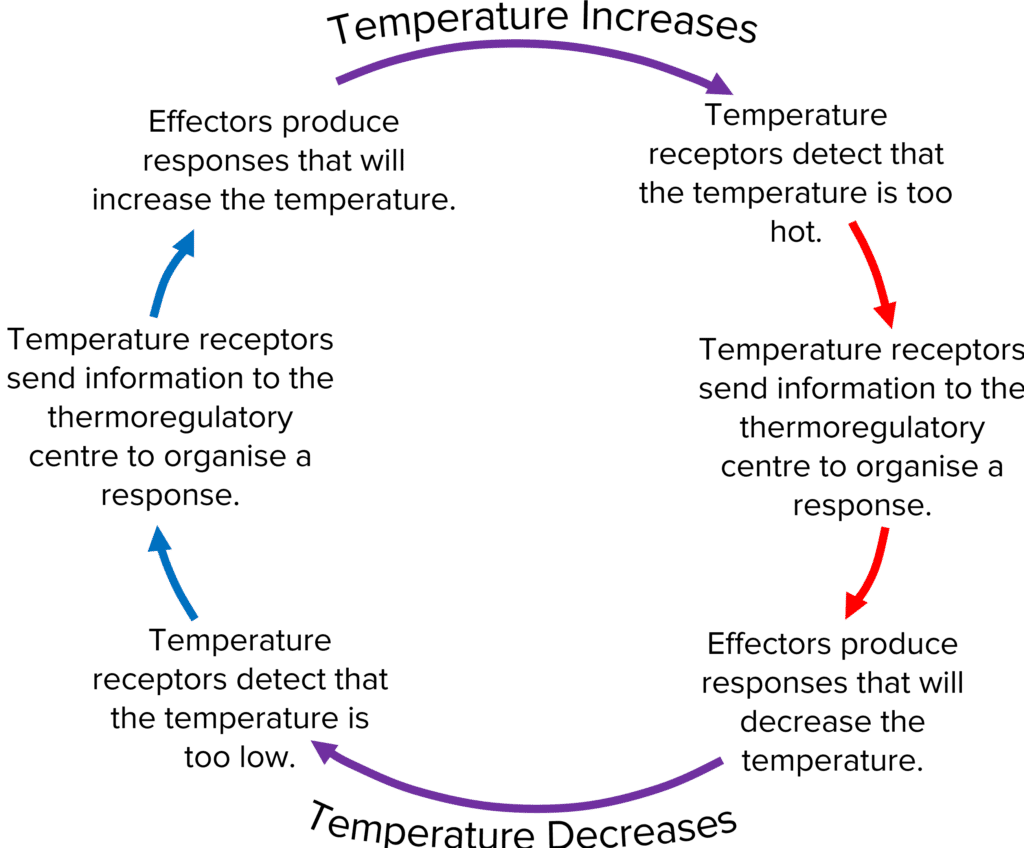Thermoregulation
Thermoregulation Revision
Thermoregulation
Part of homeostasis in humans is controlling body temperature. Humans must maintain a constant body temperature that enables enzymes to work effectively. The human body has mechanisms in place to increase and decrease body temperature when needed.
Maintaining Body Temperature
Humans control their body temperature in a process called thermoregulation. It is essential the internal body temperature is maintained at 37\degree \text{C} in order for enzymes to work effectively.
Heat energy is released into the body during respiration and then lost into its surroundings. The amount of heat energy lost and gained is regulated by the thermoregulatory centre in the hypothalamus of the brain and ensures a constant internal body temperature is maintained.

This process is controlled in a negative feedback cycle:
- Temperature receptors in the thermoregulatory centre detect that the temperature of the blood is too high or too low. Temperature receptors on the skin also detect the change in body temperature send electrical nerve impulses to the thermoregulatory centre.
- The thermoregulatory centre will then coordinate a response and send impulses to specific effectors.
- Effectors will produce responses that will increase or decrease body temperature accordingly, returning it back to normal.
Increasing and Decreasing Body Temperature
Effectors produce responses when sent impulses from control centres.
Temperature too high
When the the body is too hot it needs to lose more heat energy than it is producing to bring the temperature back down. The thermoregulatory centre sends impulses to effectors near the surface of the skin to increase heat loss:
- Sweat glands increase sweat production which evaporates from the skin, transferring the heat energy into the environment.
- Blood vessels near the surface of the skin will dilate (widen) to allow blood to flow even closer to the surface of the skin. This is called vasodilation and helps heat energy get transferred into the environment.
Temperature too low
When the the body is too cold it needs to reduce heat loss to bring the temperature back up. The thermoregulatory centre sends impulses to effectors near the surface of the skin to prevent heat loss:
- Sweat glands stop producing sweat to minimise energy transfer to the environment.
- Blood vessels near the surface of the skin will constrict to reduce the blood flow to the surface of the skin. This is called vasoconstriction and further prevents heat energy being lost into the environment.
- Hairs stand on end to trap air that insulates the body.
- Skeletal muscles start to contract automatically (shivering) to increase respiration and therefore heat energy production.
Thermoregulation Example Questions
Question 1: What should the internal human body temperature be? And why is it important that this temperature is maintained?
[2 marks]
37°C
This is the optimum temperature for enzymes in the body so ensures they are working effectively.
Question 2: Where in the brain would you find the thermoregulatory centre?
[1 mark]
Hypothalamus
Question 3: What happens when the internal body temperature gets too cold?
[6 marks]
- Change is detected by temperature receptors in the skin and in the thermoregulatory centre.
- Impulses are sent to the thermoregulatory centre to organise a response.
- Thermoregulatory centre send electrical impulse to effectors to warm the body.
Any 3 from:
- Sweat production stops.
- Vasoconstriction/ blood vessels constrict.
- Hairs stand on end.
- Automatic muscle contractions (shivering)
Thermoregulation Worksheet and Example Questions
Controlling Body Temperature Questions
GCSEOfficial MME
MME Premium Membership
£19.99
/monthLearn an entire GCSE course for maths, English and science on the most comprehensive online learning platform. With revision explainer videos & notes, practice questions, topic tests and full mock exams for each topic on every course, it’s easy to Learn and Revise with the MME Learning Portal.
Sign Up Now

